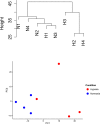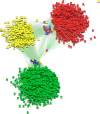Transcriptomics Modeling of the Late-Gestation Fetal Pituitary Response to Transient Hypoxia
- PMID: 26859870
- PMCID: PMC4747542
- DOI: 10.1371/journal.pone.0148465
Transcriptomics Modeling of the Late-Gestation Fetal Pituitary Response to Transient Hypoxia
Abstract
Background: The late-gestation fetal sheep responds to hypoxia with physiological, neuroendocrine, and cellular responses that aid in fetal survival. The response of the fetus to hypoxia represents a coordinated effort to maximize oxygen transfer from the mother and minimize wasteful oxygen consumption by the fetus. While there have been many studies aimed at investigating the coordinated physiological and endocrine responses to hypoxia, and while immunohistochemical or in situ hybridization studies have revealed pathways supporting the endocrine function of the pituitary, there is little known about the coordinated cellular response of the pituitary to the hypoxia.
Results: Thirty min hypoxia (from 17.0±1.7 to 8.0±0.8 mm Hg, followed by 30 min normoxia) upregulated 595 and downregulated 790 genes in fetal pituitary (123-132 days' gestation; term = 147 days). Network inference of up- and down- regulated genes revealed a high degree of functional relatedness amongst the gene sets. Gene ontology analysis revealed upregulation of cellular metabolic processes (e.g., RNA synthesis, response to estrogens) and downregulation of protein phosphorylation, protein metabolism, and mitosis. Genes found to be at the center of the network of upregulated genes included genes important for purine binding and signaling. At the center of the downregulated network were genes involved in mRNA processing, DNA repair, sumoylation, and vesicular trafficking. Transcription factor analysis revealed that both up- and down-regulated gene sets are enriched for control by several transcription factors (e.g., SP1, MAZ, LEF1, NRF1, ELK1, NFAT, E12, PAX4) but not for HIF-1, which is known to be an important controller of genomic responses to hypoxia.
Conclusions: The multiple analytical approaches used in this study suggests that the acute response to 30 min of transient hypoxia in the late-gestation fetus results in reduced cellular metabolism and a pattern of gene expression that is consistent with cellular oxygen and ATP starvation. In this early time point, we see a vigorous gene response. But, like the hypothalamus, the transcriptomic response is not consistent with mediation by HIF-1. If HIF-1 is a significant controller of gene expression in the fetal pituitary after hypoxia, it must be at a later time.
Conflict of interest statement
Figures





Similar articles
-
Long-Term Gestational Hypoxia Modulates Expression of Key Genes Governing Mitochondrial Function in the Perirenal Adipose of the Late Gestation Sheep Fetus.Reprod Sci. 2015 Jun;22(6):654-63. doi: 10.1177/1933719114561554. Epub 2014 Dec 10. Reprod Sci. 2015. PMID: 25504105 Free PMC article.
-
Ketamine decreases inflammatory and immune pathways after transient hypoxia in late gestation fetal cerebral cortex.Physiol Rep. 2016 Mar;4(6):e12741. doi: 10.14814/phy2.12741. Epub 2016 Mar 31. Physiol Rep. 2016. PMID: 27033443 Free PMC article.
-
Differential regulation of proopiomelanocortin messenger ribonucleic acid in the pars distalis and pars intermedia of the pituitary gland after prolonged hypoxemia in fetal sheep.Endocrinology. 1996 Jul;137(7):2731-8. doi: 10.1210/endo.137.7.8770892. Endocrinology. 1996. PMID: 8770892
-
Current paradigms and new perspectives on fetal hypoxia: implications for fetal brain development in late gestation.Am J Physiol Regul Integr Comp Physiol. 2019 Jul 1;317(1):R1-R13. doi: 10.1152/ajpregu.00008.2019. Epub 2019 Apr 24. Am J Physiol Regul Integr Comp Physiol. 2019. PMID: 31017808 Free PMC article. Review.
-
Gestational Hypoxia and Developmental Plasticity.Physiol Rev. 2018 Jul 1;98(3):1241-1334. doi: 10.1152/physrev.00043.2017. Physiol Rev. 2018. PMID: 29717932 Free PMC article. Review.
Cited by
-
Association between one-carbon metabolism indices and DNA methylation status in maternal and cord blood.Sci Rep. 2018 Nov 15;8(1):16873. doi: 10.1038/s41598-018-35111-1. Sci Rep. 2018. PMID: 30442960 Free PMC article.
-
A transcriptomics model of estrogen action in the ovine fetal hypothalamus: evidence for estrogenic effects of ICI 182,780.Physiol Rep. 2018 Sep;6(18):e13871. doi: 10.14814/phy2.13871. Physiol Rep. 2018. PMID: 30221477 Free PMC article.
-
Effects of ketamine on the fetal transcriptomic response to umbilical cord occlusion: comparison with hypoxic hypoxia in the cerebral cortex.J Physiol. 2018 Dec;596(23):6063-6077. doi: 10.1113/JP275661. Epub 2018 Jul 6. J Physiol. 2018. PMID: 29882596 Free PMC article.
-
Downregulation of the Vitamin D Receptor Regulated Gene Set in the Hippocampus After MDMA Treatment.Front Pharmacol. 2018 Dec 3;9:1373. doi: 10.3389/fphar.2018.01373. eCollection 2018. Front Pharmacol. 2018. PMID: 30559663 Free PMC article.
-
Chronic hypoxemia induces mitochondrial respiratory complex gene expression in the fetal sheep brain.JTCVS Open. 2022 May 5;10:342-349. doi: 10.1016/j.xjon.2022.04.040. eCollection 2022 Jun. JTCVS Open. 2022. PMID: 36004209 Free PMC article.
References
-
- Itskovitz J, LaGamma EF, Bristow J, Rudolph AM. Cardiovascular responses to hypoxemia in sinoaortic-denervated fetal sheep. PediatrRes. 1991;30(4):381–5. - PubMed
-
- Wood CE, Tong H. Central nervous system regulation of reflex responses to hypotension during fetal life. AmJPhysiol. 1999;277(6 Pt 2):R1541–R52. - PubMed
-
- Wood CE, Rabaglino MB, Chang EI, Denslow N, Keller-Wood M, Richards E. Genomics of the fetal hypothalamic cellular response to transient hypoxia: endocrine, immune, and metabolic responses. Physiological genomics. 2013;45(13):521–7. Epub 2013/05/09. 10.1152/physiolgenomics.00005.2013 - DOI - PMC - PubMed
-
- Fletcher AJ, Gardner DS, Edwards CM, Fowden AL, Giussani DA. Development of the ovine fetal cardiovascular defense to hypoxemia towards full term. AmJ Physiol Heart CircPhysiol. 2006;291(6):H3023–H34. - PubMed
-
- Liggins GC, Kennedy PC, Holm LW. Failure of initiation of parturition after electrocoagulation of the pituitary of the fetal lamb. American journal of obstetrics and gynecology. 1967;98:1080–6. - PubMed
Publication types
MeSH terms
Substances
Grants and funding
LinkOut - more resources
Full Text Sources
Other Literature Sources
Molecular Biology Databases

